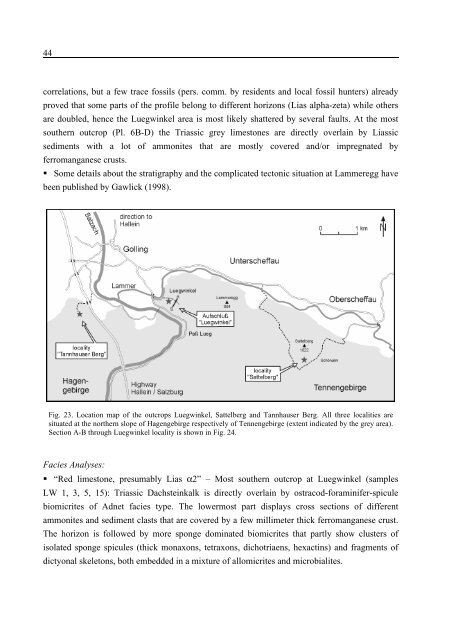Porifera-microbialites of the Lower Liassic (Northern Calcareous ...
Porifera-microbialites of the Lower Liassic (Northern Calcareous ...
Porifera-microbialites of the Lower Liassic (Northern Calcareous ...
You also want an ePaper? Increase the reach of your titles
YUMPU automatically turns print PDFs into web optimized ePapers that Google loves.
44<br />
correlations, but a few trace fossils (pers. comm. by residents and local fossil hunters) already<br />
proved that some parts <strong>of</strong> <strong>the</strong> pr<strong>of</strong>ile belong to different horizons (Lias alpha-zeta) while o<strong>the</strong>rs<br />
are doubled, hence <strong>the</strong> Luegwinkel area is most likely shattered by several faults. At <strong>the</strong> most<br />
sou<strong>the</strong>rn outcrop (Pl. 6B-D) <strong>the</strong> Triassic grey limestones are directly overlain by <strong>Liassic</strong><br />
sediments with a lot <strong>of</strong> ammonites that are mostly covered and/or impregnated by<br />
ferromanganese crusts.<br />
� Some details about <strong>the</strong> stratigraphy and <strong>the</strong> complicated tectonic situation at Lammeregg have<br />
been published by Gawlick (1998).<br />
Fig. 23. Location map <strong>of</strong> <strong>the</strong> outcrops Luegwinkel, Sattelberg and Tannhauser Berg. All three localities are<br />
situated at <strong>the</strong> nor<strong>the</strong>rn slope <strong>of</strong> Hagengebirge respectively <strong>of</strong> Tennengebirge (extent indicated by <strong>the</strong> grey area).<br />
Section A-B through Luegwinkel locality is shown in Fig. 24.<br />
Facies Analyses:<br />
� “Red limestone, presumably Lias α2” – Most sou<strong>the</strong>rn outcrop at Luegwinkel (samples<br />
LW 1, 3, 5, 15): Triassic Dachsteinkalk is directly overlain by ostracod-foraminifer-spicule<br />
biomicrites <strong>of</strong> Adnet facies type. The lowermost part displays cross sections <strong>of</strong> different<br />
ammonites and sediment clasts that are covered by a few millimeter thick ferromanganese crust.<br />
The horizon is followed by more sponge dominated biomicrites that partly show clusters <strong>of</strong><br />
isolated sponge spicules (thick monaxons, tetraxons, dichotriaens, hexactins) and fragments <strong>of</strong><br />
dictyonal skeletons, both embedded in a mixture <strong>of</strong> allomicrites and <strong>microbialites</strong>.

















